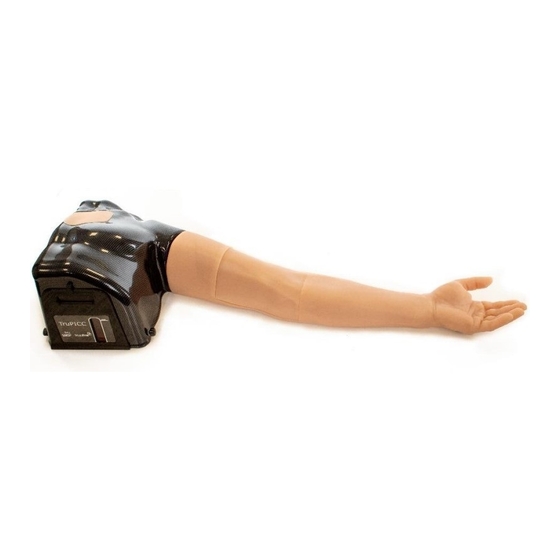
Table of Contents
Advertisement
Quick Links
TruPICC
User Manual
Part of the TruUltra product range, TruPICC is an anatomical adult male arm
designed for teaching the skills associated with ultrasound guided PICC line and
Intravenous (IV) techniques.
TruPICC develops the user's skills associated with needle placement, guidewires
and catheters. The upper arm anatomy features the brachial, basilic, cephalic
and median cubital veins, the superior vena cava and the brachial artery for
vessel differentiation.
1
Advertisement
Table of Contents

Subscribe to Our Youtube Channel
Summary of Contents for TruCorp TruUltra TruPICC
- Page 1 TruPICC User Manual Part of the TruUltra product range, TruPICC is an anatomical adult male arm designed for teaching the skills associated with ultrasound guided PICC line and Intravenous (IV) techniques. TruPICC develops the user’s skills associated with needle placement, guidewires and catheters.
-
Page 2: Table Of Contents
Contents Product specifications ..........................3 Package Contents ........................... 3 Recommended equipment sizes ......................3 Initial set-up information ........................4 Fluid system preparation ........................5 Re-filling the fluid system ........................7 IV cannulation ............................7 PICC line ..............................8 Replacing the ultrasound insert ......................9 Removing excess fluid from the system .................... -
Page 3: Product Specifications
• Size 4F PICC catheter with soft tip guidewire, single lumen, and approx. 55-60cm length • Using equipment sizes outside of TruCorp’s recommendations can cause permanent damage to the model and the product warranty will be void (please refer to page 16 for... -
Page 4: Initial Set-Up Information
Initial set-up information 1. Gently remove the model from the carrier case and place on a suitable flat surface 2. In line with clinical guidelines, ultrasound gel should be applied to the ultrasound probe prior to use to ensure a high-quality ultrasound image is obtained 3. -
Page 5: Fluid System Preparation
Fluid system preparation 1. Mix the required concentration of the artificial blood supplied with the model (product code: CVB250) as indicated on the bottle’s instructions (ratio of blood to water is 1:9). Distilled water can be used as a substitute for blood if desired 2. - Page 6 4. Switch the ‘CEPHALIC’ vein network to ‘OFF,’ before switching the ‘BASILIC’ vein network to ‘ON’ to allow blood to be inserted into the basilic vein: 5. Re-fill the syringe with blood as required and slowly insert 60ml, ensuring the syringe does not contain air bubbles.
-
Page 7: Re-Filling The Fluid System
Re-filling the fluid system 1. Users can remove fluid through the syringe after the veins have been cannulated to confirm correct needle placement. Please note that the volume of fluid previously withdrawn will need to be refilled to maintain a high-quality ultrasound image for further training 2. -
Page 8: Picc Line
PICC line 1. In line with clinical guidelines, ultrasound gel should be applied to the ultrasound probe prior to use to ensure a high-quality ultrasound image is obtained 2. PICC line can be performed using the basilic or cephalic veins 3. -
Page 9: Replacing The Ultrasound Insert
Replacing the ultrasound insert 1. Gently pull back the skin at the side of the insert (closest to the product’s shoulder) and remove the large pin: 2. Press the metal studs to loosen the insert:... - Page 10 3. Gently remove the insert from the model and discard: 4. Align a new insert correctly into position and perform the reverse of steps 1-3 (starting with step 3) as above. Please ensure all connectors are securely placed:...
-
Page 11: Removing Excess Fluid From The System
Removing excess fluid from the system When the fluid container reaches ‘MAX’ level, it is necessary to empty the blood: 1. Open the latch: 2. Loosen the screws on both sides of the container:... - Page 12 3. Gently remove the container and disconnect the tube by pressing the metal studs: 4. Remove the plug from the area indicated below: 5. Empty the container (approx. 1 litre of fluid when full):...
- Page 13 6. When the container is empty, perform the reverse of steps 2-5 (starting with step 5) as above. Please ensure all connectors are securely placed:...
-
Page 14: Removing All Fluid From The System
Removing all fluid from the system This is recommended when the model is being transported, or kept in storage for extended periods of time (keeping fluid in the system short-term will not damage the model) 1. Switch the ‘CEPHALIC’ vein network to ‘ON’ to remove blood from the cephalic vein and connect an air-filled syringe to the connection (please disregard the blood in the syringe shown below, the syringe should contain air only for removal of fluid): 2. -
Page 15: Faq And Useful Tips
FAQ and useful tips 1. Why can’t I visualise the veins clearly? Poor quality ultrasound images are caused by air inside the blood. To improve the image, insert more blood into the cephalic and basilic veins (please refer to the fluid system preparation on page 5). Approx. 10-20ml per vein Image on left shows air bubbles negatively impacting image quality;... -
Page 16: Care And Maintenance
Upon examination by TruCorp, if the unit is found to be defective it will be repaired or replaced at no charge. TruCorp will pay for the freight/delivery and the actual parts needed free of charge if any part of the product fails within the 1-year period. - Page 17 Warranty is void if third party products are seen to have damaged or caused the failure of the TruCorp models. Please direct all warranty and repair requests/inquiries to:...



Need help?
Do you have a question about the TruUltra TruPICC and is the answer not in the manual?
Questions and answers